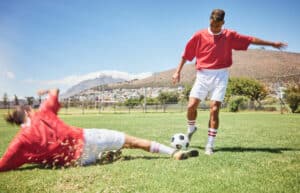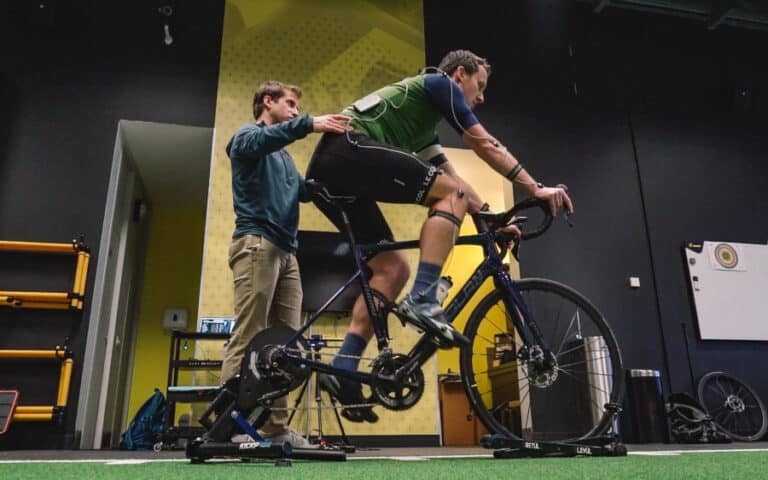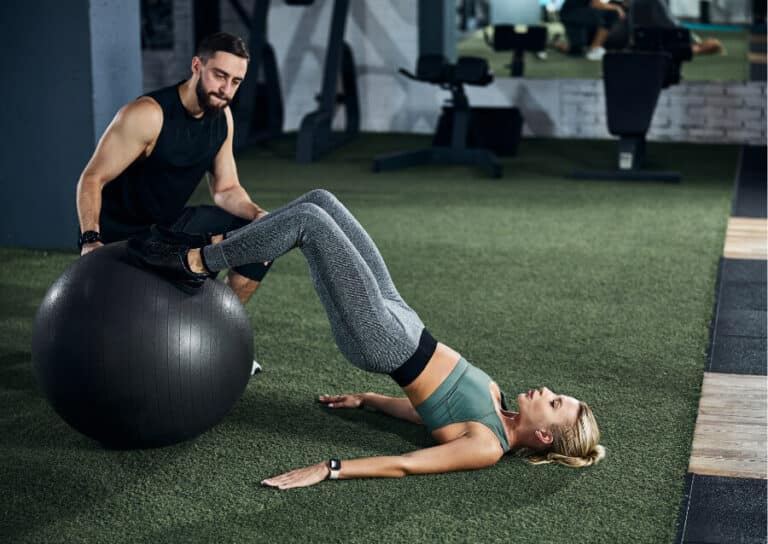Mechanism and subjective history
The syndesmosis joint is maximally stressed in dorsiflexion with external rotation of the ankle. This often occurs as a contact injury, for example in a block tackle or with the foot getting caught under an opponent, but can also be caused by landing or cutting. The subjective history will inform the suspected diagnosis.
The mechanism associated with syndesmosis injury is that of direct impact to the syndesmosis region with a forced lateral rotation of the foot (relative to the tibia) with the ankle in dorsiflexion. This can occur in reverse with the tibia medially rotating over a fixed foot; the end range position is the same with the foot ending up dorsiflexed and laterally rotated.

This forced rotation coupled with the mortise shape of the joint results in an outward force within the syndesmosis joint and injury to the one or all of the main supporting structures.
In effect, the syndesmosis is forced apart by these rotational forces.
Although these are seen as an ankle injury in truth they can be viewed as an injury of the lower shin with a disruption of the structures which form the mortice joint that the Talus sits within. The distal Tibia and Fibula are joined together by strong fibrous ligaments (AITFL, PITFL and IOL) and the interosseous membrane which sits between the length of the bones.
From a functional perspective, the ligaments of the syndesmosis are of course closely connected with the lateral and medial ligaments of the ankle and an injury to the syndesmosis will often involve some of or all of the medial (Deltoid) or lateral (especially ATFL) ligaments.
More information on the specific injured structures can be found here
https://www.orthobullets.com/foot-and-ankle/7029/high-ankle-sprain-and-syndesmosis-injury
Grade 1/low grade
Able to continue. The player may be aware of symptoms but has good function jumping, running, turning and tackling. Does not report feeling of instability, can often continue but be sore and swollen after activity.
Grade 2
May need to be withdrawn immediately or may try to continue. The player will likely experience significant symptoms if continuing, and reduced performance. For example, instability, an inability to push off and a lack of power when jumping or changing direction – these injuries will fall into 2A (stable) or 2B (unstable). Determining the stability will be key in determining if surgical or conservative management is indicated.
Grade 3
Will need to be withdrawn, often with assistance. High pain and dysfunction. Mechanism involves significant force – these injuries are likely to require surgical stabilisation.
On further assessment, the player will often complain of pain superior to the talocrural joint line, with posterior pain if there is PITFL involvement. More significant disruption of the interosseous membrane may cause the player to report an unusual feeling like the “two shin bones are separating” on weight-bearing. Syndesmosis injuries can present with relatively low pain compared with a medial or lateral ankle sprain, with more often a feeling of instability or lack of function.
Key clinical point – disruption of the PITFL is often a key clinical marker for likely instability.
This paper gives more information on the various grades of syndesmosis injuries and suggested management strategies
https://www.aspetar.com/journal/upload/PDF/2014127152113.pdf
Objective examination
Observation
The swelling pattern will typically be above the talocrural joint for syndesmosis injury. Medial and lateral ankle structures can also be injured, which may cause swelling distally. The clinician should also note any sign of an ankle fracture deformity (distal or proximal fibula).
Palpation
Careful early palpation before significant swelling occurs is important. Key structures should be palpated and will give an indication of injury (ATFL, CFL, PTFL, deltoid complex, AITFL, PITFL, IO membrane, length of fibula and tibia, talus).
Weightbearing status
Check the player’s ability to walk, and particularly ability to load in DF. Although it should not be over-stressed with excessive assessment, ability/confidence to hop should be noted.
ROM
Pain and a reluctance to move into dorsiflexion will be present if a syndesmosis injury is present. The extent of pain-free range available (knee to wall score) and degree of pain (VAS) should be noted and compared to their normal score. Other ankle movements (PF, Inv, Ever), as well as knee ROM, are checked to assess other involved structures.
Special tests
- Dorsiflexion plus external rotation test. This stresses the syndesmosis so should be tested carefully and as few times as possible (not by several practitioners).
- Squeeze test: grasp midway down the lower leg and apply a compressive force to the tibia and fibula. Positive for pain on this test may be prognostic of a longer RTP (Morgan et al., 2013, Sikka et al., 2012)
- An inability to perform a single leg hop has the highest sensitivity of any syndesmosis special test (Smam et al. 2015).
- Fibula AP glide. May reproduce pain and have excessive movement compared to the uninjured side.
- Ligament stress tests for medial and lateral ankle ligaments.
- Cotton test
Radiology
Accurate clinical assessment should inform the need for imaging. Suspicion of significant structural damage to the ankle or syndesmosis warrants MRI. Any suspicion of bony injury should be x-rayed (follow Ottawa rules.
More information on the Ottawa rules for ankle injury here
https://www.physio-pedia.com/Ottawa_Ankle_Rules
The key information required from MRI is
- Syndesmosis structures. AITFL, PITFL, interosseous ligament and interosseous membrane. Extent of oedema and amount of structural damage should be noted.
- A “broken ring of fire” sign may be noted by the radiologist, which indicates a pattern of oedema 4-6cm above the ankle joint surrounding the tibial periosteum, as a result of IO membrane trauma. Although sensitivity for syndesmosis injury associated with this is low (49%), specificity is high (98%). This therefore helps to differentiate the diagnosis of an acute syndesmosis injury from an acute LAI with chronic syndesmosis ligament oedema/thickening (Calder et al., 2017).
- Deltoid ligament. The syndesmosis injury mechanism will also often stress the medial ankle.
- Lateral ankle: Occasionally the ATFL may be involved in a syndesmosis injury.
- Proximal tib-fib joint. The proximal shin can also be involved, therefore the presence and grade of STFJ injury should be noted.
- Chondral surfaces. Osteochondral injuries or avulsions should not be missed, with a high index of suspicion with high-force injuries.
- Further imaging. A weightbearing X-ray and/or a weightbearing CT scan, may be required. This may be suggested by the consultant to assess the degree of joint diastasis and instability, which will ultimately inform the surgical management decision.
The Sikka grading system is used to interpret image findings, since it clearly details the extent of damage to the structural support around the joint. From this, stability of the joint can be estimated, because a study by Porter and colleagues demonstrates the specific contribution of AITFL (35%) PITFL (41%) and IOL (21%).
It’s worth noting that the Sikka grading system is specific to radiological findings and slightly different to the clinical grading system – be clear on which system you are using when discussing with colleagues.
Sikka grading –
Grade 1 – isolated injury to the AITFL.
Grade 2 – injury to the AITFL and IL.
Grade 3 – injury to the AITFL, IL and PITFL.
Grade 4 – injury to the AITFL, IL, PITFL and deltoid ligament.
Clinical grading –
- Grade I: Involves injury to the anterior deltoid ligament and the distal IL but without tearing of the more proximal syndesmosis or the deep deltoid ligament. The AITFL is often very tender to palpation and may have a higher-grade injury; because no diastasis is present, the injury is, by definition, stable.
- Grade II: involves disruption of the anterior and deep deltoid ligaments as well as a tear in a significant portion of the syndesmosis, resulting in a POTENTIALLY unstable ankle that is still normally aligned on non-stress radiographs. This poses particular diagnostic challenges, because the extent of the injury and its occult instability are often more difficult to recognise (see below for Grade 2A v 2B decision making).
- Grade III: Involves severe external rotation and abduction, with complete disruption of the medial ligaments and extensive disruption of the syndesmosis, frequently accompanied by fracture of the proximal fibula. Such injuries are overtly unstable on initial examination and standard radiographs.
Is surgery required to stabilise the joint?
In the case of clinical Grade 1 injuries and Grade 3 injuries the decision to stabilise is clear. Grade 1 will never be a stabilisation case and Grade 3 will always be.
In the Grade 2 cases this is where a combination of the injured structures (as highlighted on MRI) and functional stability of the joint (using the tests advised above) will give the clinician assessing the joint a decision to make in terms of conservative or surgical management.
It is strongly advised to wait a minimum of 5 days before carrying out stressing of the joint to give initial pain and swelling a chance to subside, similarly, the initial MRI can often be over reported in terms of injured structures and the importance of accurate palpation can not be underestimated.
As a rule of thumb, positive MRI findings which don’t correlate with tender superficial structures should be interpreted with caution and the individual given every opportunity to rehabilitate without the need for surgical stabilisation.
*A key study by Calder et al (2016) consisted of Sixty-four athletes with an isolated syndesmosis injury (without fracture) who were prospectively assessed, with a mean follow-up period of 37 months (range, 24 to 66 months). Those with an associated deltoid ligament injury or osteochondral lesion were included. Those whose injuries were considered stable (grade IIa) were treated conservatively with a boot and rehabilitation. Those whose injuries were clinically unstable underwent arthroscopy, and if instability was confirmed (grade IIb), the syndesmosis was stabilized. Clinical and magnetic resonance imaging assessments of injury to individual ligaments were recorded, along with time to return to play. All athletes returned to the same level of professional sport.
The 28 patients with grade IIa injuries returned at a mean of 45 days (range, 23 to 63 days) compared with 64 days (range, 27 to 104 days) for those with grade IIb injuries. There was a highly significant relationship between clinical and magnetic resonance imaging assessments of ligament injury (anterior tibiofibular ligament [ATFL], anterior-inferior tibiofibular ligament [AITFL], and deltoid ligament. Instability was 9.5 times as likely with a positive squeeze test and 11 times as likely with a deltoid injury. Combined injury to the anterior-inferior tibiofibular ligament and deltoid ligament was associated with a delay in return to sports. Concomitant injury to the ATFL indicated a different mechanism of injury-the syndesmosis is less likely to be unstable and is associated with an earlier return to sports.
Key components of rehabilitation
Accurate assessment and optimal acute management
This involves removing the player from play if required, not over-assessing to further stress the injury, and applying good acute management. This includes placing in a high ankle aircast boot, providing crutches, compression, elevation and cryotherapy.
Avoiding aggravating movements to allow optimal early healing
Dorsiflexion should be avoided in the early stages, until the movement can be safely introduced. Exercises such as calf stretches, squats, lunges will likely include large dorsiflexion stress. An eventual return of full dorsiflexion is important and should be gradually introduced and maximised before RTP.
Appropriate loading of local ankle structures
The Alter-G is used to progress the weightbearing status and gradually increase the load tolerance of the injured structures. A graded strength programme is used to target the local ankle stabilisers.
Jump and land progressions
High velocity, multi-direction exercises are progressed gradually, with explosive and reactive strength markers assessed before RTP.
Avoid reproducing high-stress positions until the end of rehab
Block tackle, max kicking, high-speed CoD must be included in the end-stage rehab sessions to provide the ultimate test for the ankle. Gradual exposure to these is included in gym and on-pitch work throughout.
Summary
Syndesmosis (or high ankle) injuries were often seen as difficult to manage. However an improvement in injury recognition, radiological grading, early management and more progressive rehab means these are not an injury to be feared.
Protect them in the early phases by using a protective boot, progress them gradually and take close note of the impact on any progression on dorsiflexion (knee to wall) and the recovery should be fairly simple.
In the end stages the usual performance markers and objective information should be utilised to determine when a full recovery has been made including Hop, Triple Hop, Drop Jump, CMJ and local ankle musculature strength using HHD, IKD or Force Plates depending on the technology which is accessible.
The most commonly seen complex injury not requiring stabilisation surgery should typically look to be back in full activity by around 6 weeks.
You can listen to more about Syndesmosis injuries in this podcast by Chris Morgan
https://www.clinicaledge.co/podcast/physio-edge-podcast/80
A follow-up case study will detail the rehabilitation process in more detail.












